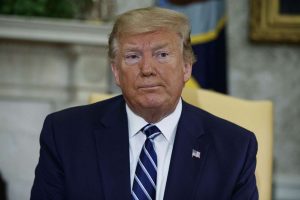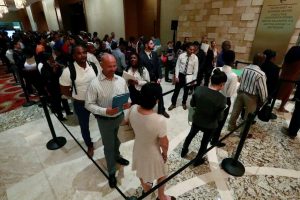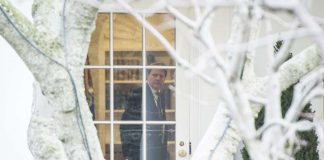JUNE 24, 2019
 There is a good chance President Donald Trump will be seeking a second term with the economy slowing and unemployment rising. – Evan Vucci/AP Photo
There is a good chance President Donald Trump will be seeking a second term with the economy slowing and unemployment rising. – Evan Vucci/AP Photo
In just one week, the current economic expansion will turn 10 years old and officially become the longest in American history, an occasion likely to elicit bragging from the White House.
But it will also highlight a major risk for President Donald Trump.
Signs of a slowdown are mounting with weaker job growth, reduced manufacturing activity and a nervous Federal Reserve hinting at slashing interest rates — suggesting that Trump could suffer from terrible economic timing.
All recent presidents other than Bill Clinton experienced slowdowns in their first terms, but most sought reelection as the economy was improving. No president since Calvin Coolidge in 1924 has held on to the White House during an election year marred by recession.
Trump may avoid running for reelection in an official recession, especially if he gets his much desired rate cuts from the Fed. But there is a good chance he’ll be seeking a second term with the economy slowing and unemployment rising, especially if he continues to engage in bruising trade battles.
Voters tend to lock in their assessment of a president’s performance on the economy a few months before Election Day, meaning Trump’s strongest argument for four more years may not wind up being all that strong.
“The economy has been a tailwind for him, but by Election Day next year it will at best no longer be blowing,” said Mark Zandi, the chief economist at Moody’s Analytics who maintains a model gauging how economic trends influence voting outcomes. “And there is a reasonable probability that he will be facing an economic headwind for reelection with growth slowing to the point that unemployment is starting to rise next year, though a lot depends on what he does with the trade wars and what the Fed does in response.”
Economic numbers in the second quarter of an election year — in this case April through June of next year — tend to exert the biggest impact on election outcomes, Zandi notes. That’s when voters focus on the race and their own economic situation and before they get distracted by summer vacations.
That means Trump’s strongest economic performance — a growth rate close to 3 percent in 2018, boosted by a big tax cut — might have come too soon for electoral purposes.
Trump in fact might be better off with a shallow recession right now — generally defined as a pair of quarters with shrinking GDP — with growth picking up again next year heading into the election.
“If there is going to be a recession, it’s probably good to get it over early,” said Karlyn Bowman, polling analyst at the American Enterprise Institute. “His marks on handling the economy and jobs are just about the only positive marks he has.”
A near-term recession still does not seem likely. Economic forecasters see a slide back into growth between 1 and 2 percent as the impact from the tax cut fades, economies outside the U.S. struggle and trade tensions linger.
The Fed is predicting 2.1 percent growth this year and 2.0 percent next year, with the unemployment rate rising slightly next year to 3.7 percent from 3.6 percent.
The rate of job growth has already slowed to an average of 151,000 over the last three months, down from an average of 238,000 earlier in the year. That’s enough to keep the unemployment rate from rising but not by much.
Readings on manufacturing activity in the Philadelphia and New York regions this month registered sharp declines just as Trump was threatening tariffs on Mexico. And in its announcement on interest rates last week, the Fed said that “indicators of business fixed investment have been soft.”
 Job applicants line up June 4 during a job fair in Hollywood, Fla. Unemployment remains low at 3.6 percent but job growth has been sluggish in recent months. – Wilfredo Lee/AP Photo
Job applicants line up June 4 during a job fair in Hollywood, Fla. Unemployment remains low at 3.6 percent but job growth has been sluggish in recent months. – Wilfredo Lee/AP Photo
The administration’s main argument that growth will pick up again is based on the belief that the tax cuts, which lowered corporate rates and incentivized investment, would produce a sustained boom in business spending. That could still materialize — but it hasn’t yet.
The White House is strongly sticking to that argument, dismissing predictions of a sharp slowdown and continuing to promise that job gains will pick up again and growth will stay at a 3 percent pace, providing a solid backdrop for the reelection campaign.
“We should expect a bounce back. The labor market fundamentals are very strong and haven’t changed very much,” Kevin Hassett, the outgoing chairman of the White House Council of Economic Advisers, said in a recent interview. “The last two years we grew at a healthy clip because we became an attractive tax climate and we deregulated aggressively. It feels like those fundamentals are still in place.”
Right now, the economy remains Trump’s strongest issue, though his high ratings on the subject have not lifted his overall approval rating. And his numbers on the economy are already showing some signs of slipping.
A Fox News poll last week found that 57 percent of voters feel optimistic about the economy, down from 66 percent when Trump took office and 63 percent in February. The survey found that 48 percent of voters believe Trump’s policies “help people with more money,” 31 percent said they help everyone and just 5 percent said they help “people like me.”
A Quinnipiac survey last month found that 39 percent approve of Trump’s trade policies while 53 percent disapprove.
In critical swings states that carried Trump to the White House in 2016 — Pennsylvania, Michigan, Wisconsin, Ohio and Iowa — voters disapprove of the president’s handling of trade by 56 percent to 41 percent.
Consistent high ratings on the economy as an issue have also never pushed Trump’s job approval rating over 50 percent, suggesting the president is not getting a large amount of credit for economy. Trump suggested in an interview with Time last week that he may not even try to convince swing voters that they should back him. “I think my base is so strong, I’m not sure that I have to do that,” he said.
If he decides he needs to woo swing voters, Trump will likely have a more difficult time doing so if forecasts of a slowing economy in 2020 come true. “He had a strong blip last year with the deficit-financed tax cut, but that stimulus is gone and we are left with trend-line underlying growth,” said Zandi. “The link between the tax cut and long-term growth was investment, and investment has flat-lined since last year. The president will be lucky if we stay at 2 percent because right now we are below it.”
Courtesy/Source: Politico










































































































